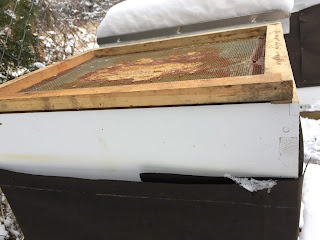Easy sugar bricks for you to make for your honey bees to help sustain them during the cold Michigan winter months.
 |
| The finished product of sugar bricks. The larger ones made in foil roaster pan are about 3 1/2 pounds, the smaller ones around two pounds. See below for directions on how to make. |
Ingredients needed:
Water 3/4 cup
Vinegar 1/4 cup
Honey B Healthy or equivalent. 1 tsp
Granulated Sugar 10 pounds
Items needed:
5 gallon bucket
Drill
Paint mixer paddle to attach to drill
Foil pans
Knife
Measuring cup
Teaspoon
Many ask what type of sugar to use. I've heard arguments on both sides whether it should be beet or cane, organic or non organic, etc... I use white granulated cane sugar from Costco. A 50 pound bag is $20 bucks. So if I make my bricks to be about 2 pounds each, that is 25 bricks, about 80 cents a brick.
It is worth the time and money to make the sugar bricks for your bees. It only takes a couple of minutes to pop one on to the top bars above the cluster. Yes, you can take the top cover off in the winter in cold temps without hurting them. Just do it quickly, less than a minute or two. Even if they have honey stores all around them, it may be too cold for the cluster to move to the full honey frames. A brick on top of the cluster will get them through until temps increase again and allow them to move. Don't let your bees starve! It would be a shame if they survived viral infections from varroa, pesiticide exposure and other challenges they face to die of starvation when it could have been easily prevented. Not to mention the cost of a few sugar bricks is way less than having to purchase new bees in the spring because yours are all dead.
 |
| Bucket to mix the sugar, drill, paint mixer paddle. I mix it up in the garage. |
 |
| 3/4 cup water (sorry that is a 4 cup measuring cup that is why it doesn't look like 3/4 cup) add 1/4 cup vinegar and 1 tsp Honey B Healthy into it. |
 |
| Mixing for 3-5 minutes with paint mixer attached to power drill. |
 |
| Tinfoil pans to pour mixture into when finished mixing. I use a variety of sizes. |
 |
| Dump the mixture from the bucket into your tins. |
 |
| Use your hands or a rolling pin to really compact the mixture into the pan, making sure it is dense. |
 |
| Your oven temp for the bricks should be around 140-180 degrees Farenheit. |











